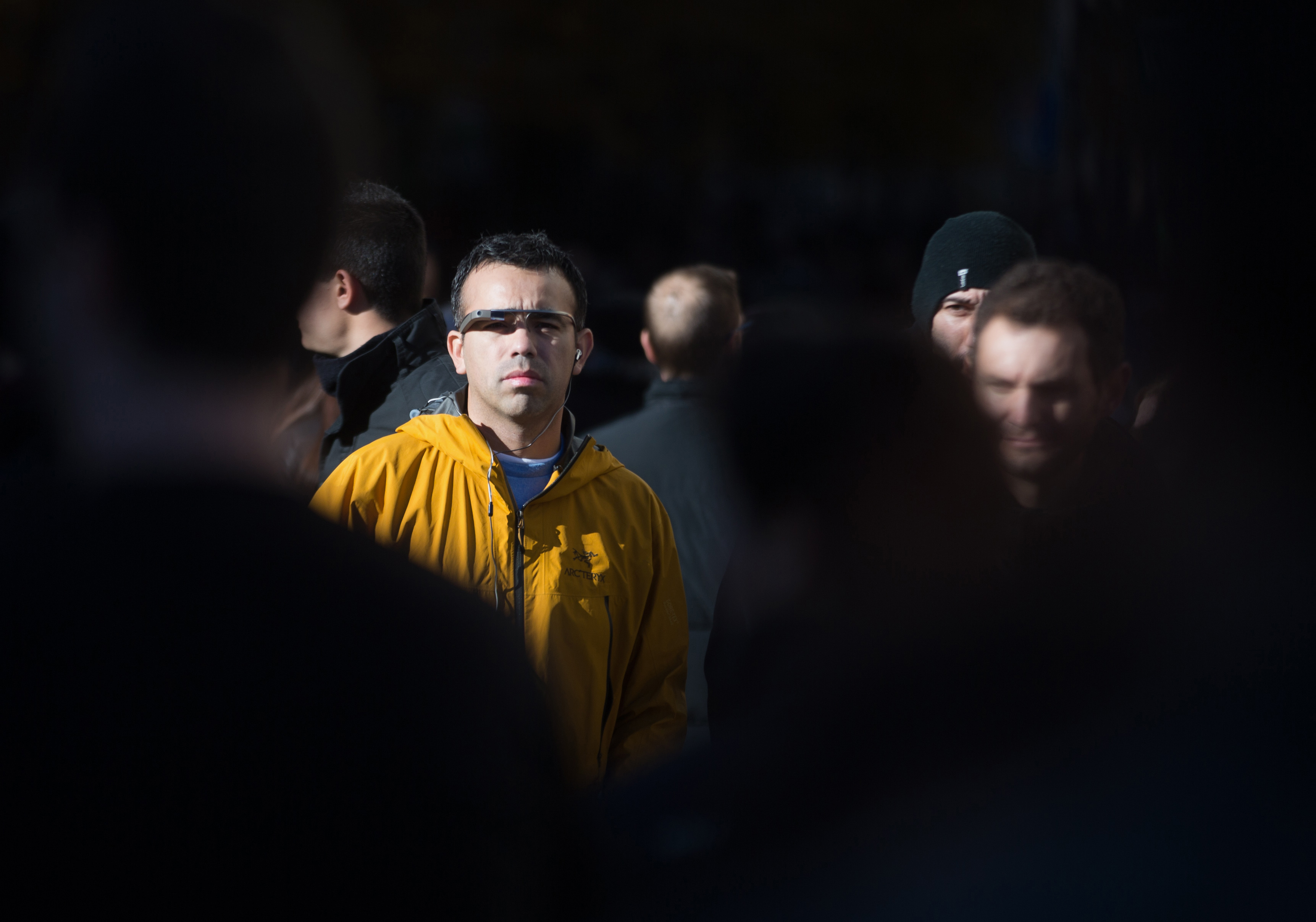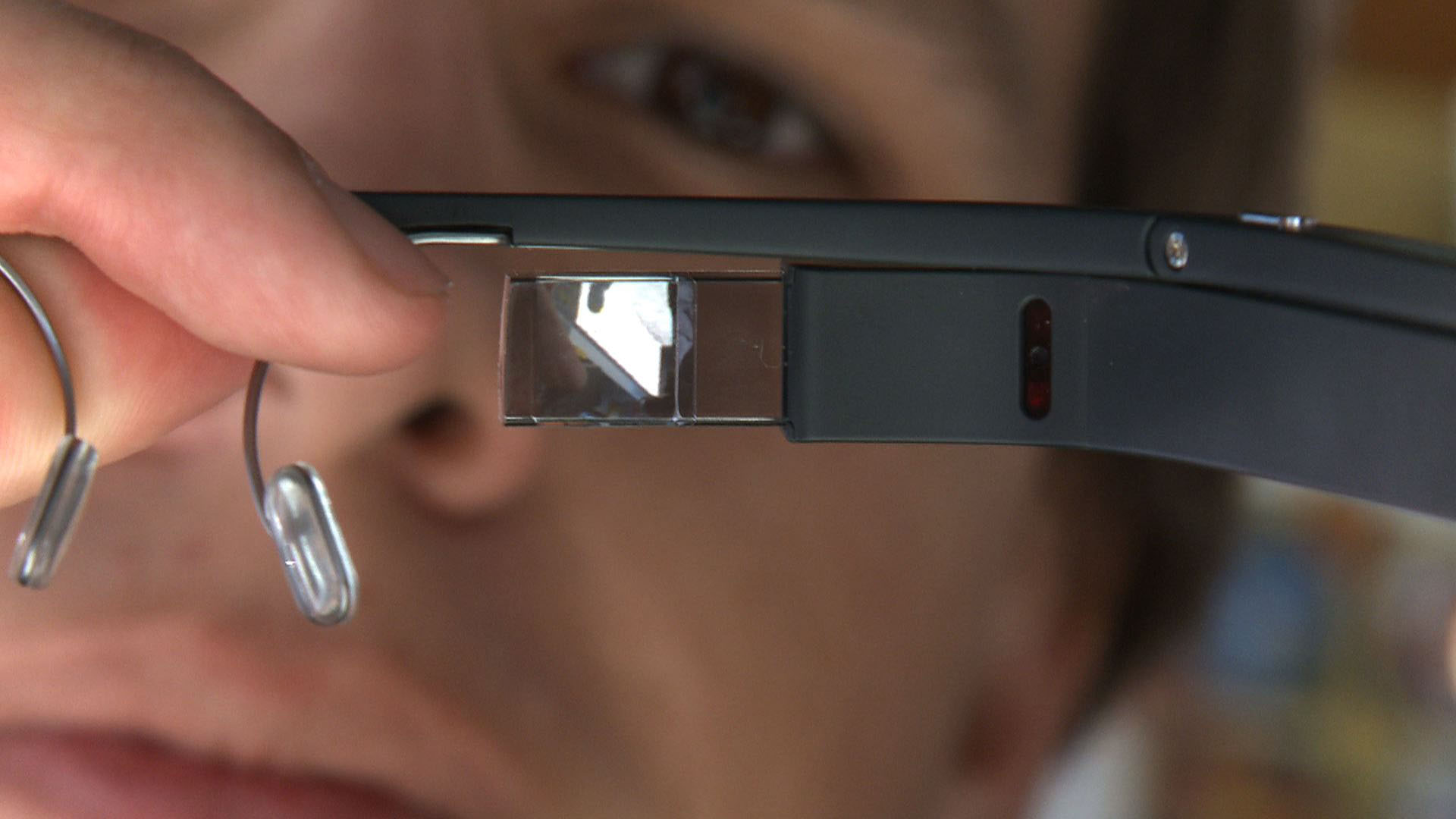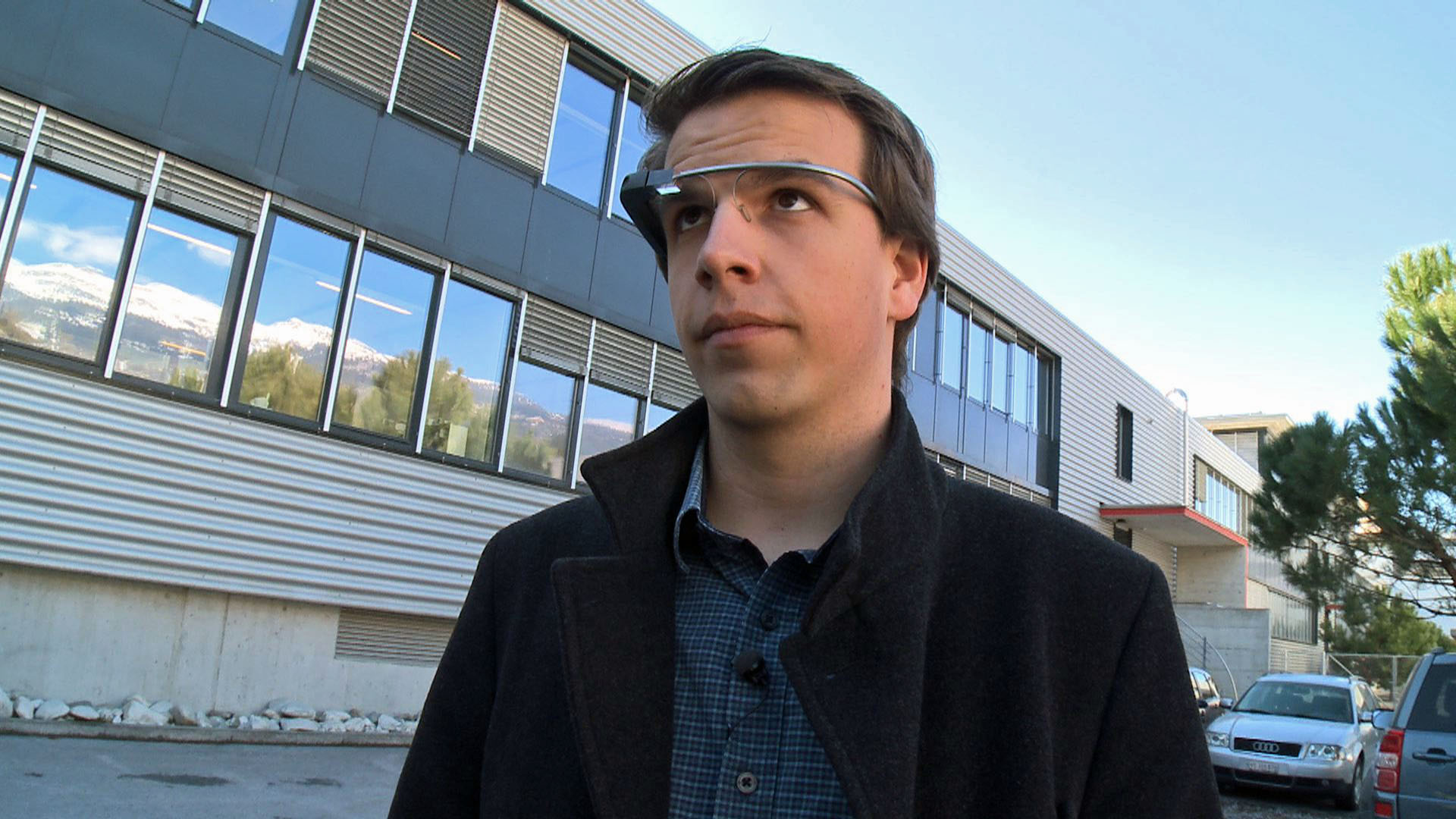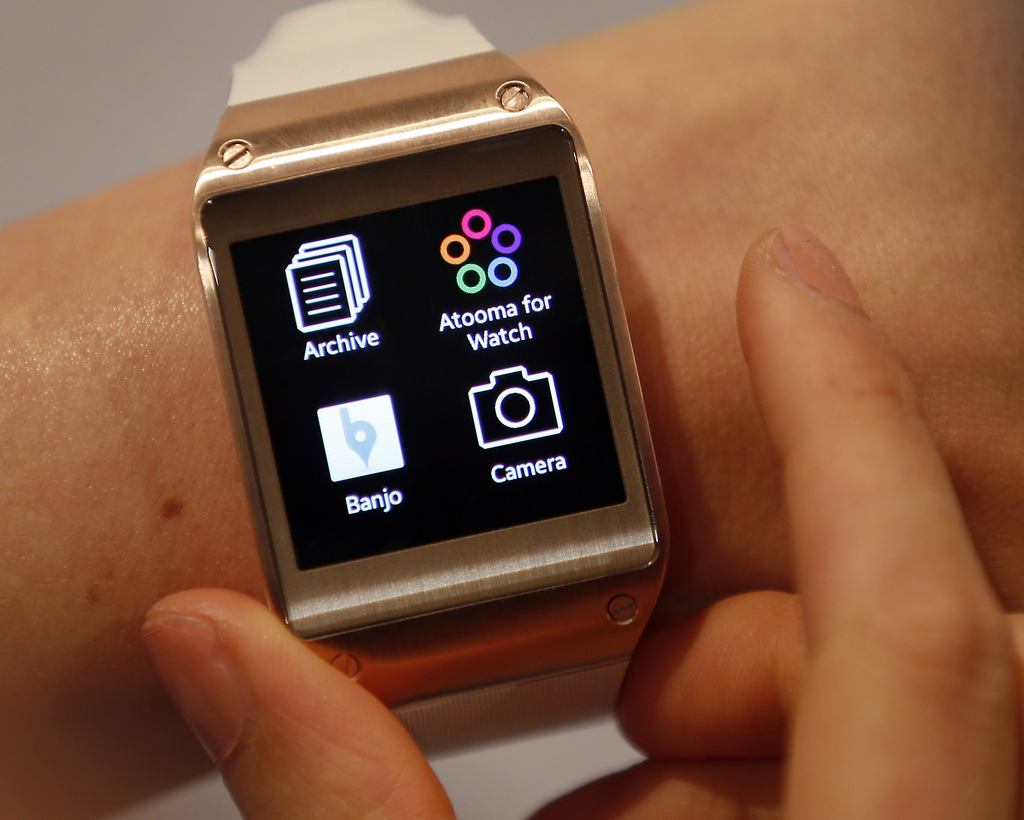The future is coming to your face soon

The wearable technology Google Glass has not hit the market yet, but developers – including a handful in Switzerland – are rushing to build apps for the new device to take advantage of what they hope is the “next big thing”.
Benoît Golay takes the lid off the square white box and passes me the futuristic metal-framed eyewear with a stamp-sized electronic screen on the side.
“I agree, they look a bit Robocop,” smiles Golay, a business development manager at Icare Institute, a non-profit cantonal research centre in Sierre.
I carefully slip them on and tap the plastic frame. A tiny screen appears with the words “OK Glass” floating a few centimetres to the right in front of my face. Another tap on the frame, or a repeat of the words “OK Glass”, and you get a menu with – for the moment – a limited list of options, such as “take a picture” or “get directions”.
To get it going you have to hook up to a smartphone via a wireless or Bluetooth connection.
The device, like my own glasses, is light, and the screen doesn’t seem to affect my field of vision. Despite all the concerns, it doesn’t feel that odd to wear, but then again there’s no one around to see me.
This early version of Google Glass is mostly in the hands of American testers, developers and hardcore tech-fans.
Icare managed to get an industry example last November thanks to contacts in the US, and after paying the $1,500 (CHF1,300) price tag. Their development team has since been busily exploring the potential of their new toy.
Last month Icare showed off the one of their two Glass prototypes at the Mobile World Congress in Barcelona: an application that allows the user to scan barcodes on product packaging to receive reliable information such as nutritional content or whether the product is suitable for people with allergies.
The app was developed in collaboration with GS1, the supply chain standards organisation that manages the system of product barcodes used by over one million companies on billions of products across the world, and Open Mobile Alliance, the wireless industry’s focal point.

More
Google Glass reveals product info
A whole new Glass app ecosystem is fast emerging. Over 100 apps are reportedly now available, despite Glass only being accessible to a limited number of early users (40,000-60,000 pairs in circulation), mostly in the US. It is expected to go on sale to the American public at the end of 2014.
There are apps to shop “smarter”, indicate your speed while cycling, keep up to date with the news or simply play games. Apps to check your bank balance, translate foreign signs or alert you when you nod off while driving.
As an app developer, Golay said Icare still faced lots of unknowns: “We don’t know when Glass will come out exactly in Europe. We don’t know whether we’ll be free to publish apps or how many, whether there’ll be a Glass store dedicated to apps or if Google is managing it.”
He doesn’t believe the device will replace the mobile phone, but he is convinced of its potential, and says it could well become the ideal future technology for identifying objects and providing the appropriate information at the right time.
The computer eyewear, which incorporates voice-command features as well as GPS, gyroscope, compass and wireless capabilities, has been relatively easy to work on, said Golay.
Google says the $1,500, price tag will be lower when the consumer version of Glass goes on sale to the general public towards the end of 2014. It is expected to go on sale in Europe in 2015.
The device needs to hook up to a mobile phone to take advantage of its internet connection when there is no wireless link. The stamp-sized electronic screen mounted on the left side of a pair of eyeglass frames gives information to the user who can also hear sounds via the sidearm.
At present Glass can take pictures, record video, access email, receive Google Now information, provide turn-by-turn driving directions, make calls via Google+ and retrieve certain info from the internet.
Google is likely to face a number of eyewear competitors including Samsung and Microsoft who are said to be working on similar technologies.
The device is light and robust, but there are still several major constraints, such as the battery autonomy, which Google claims to stretch to 3-4 hours, but more like 1.5 hours. If used intensively they also tend to heat up.
“There are also problems with the camera as there is no autofocus; it has difficulty managing objects at distance,” said the Icare manager. In order to read a product barcode you currently have to stand a maximum of 25cm away.
The camera and focusing is also an issue with Icare’s second prototype, an application that can identify car number plates, but which Golay stresses is not being developed for the police.
“This is not something we plan to commercialise. It’s more of a technical challenge,” he noted.

More
Identifying parking cheats
Sierre appears to have become a hub for other Glass developers. At the University of Applied Sciences and Arts Western Switzerland (HES-SO) teams are working on an e-learning app as well as several medical apps that can deliver information to doctors examining patients, and collect and share images of patients.
“With Glass things would be much less disruptive. You could stream video so doctors at a hospital could see what was going on at an accident scene, how many injured there were, for example. They could then prepare the operating theatres accordingly,” said Henning Müller head of the HES-SO e-health unit. They aim to have prototypes available by June.
In the US doctors have already started using Glass healthcare apps. Pilot programmes transmitting live video and audio of patients from Glass to computers, smartphones and tablets have already been trialled at the University of California and are set to be rolled out at outpatient clinics in southern California.

Last December a cardiothoracic surgeon at UCSF Medical Center completed a three-month trial of Glass in the operating theatre. The results were mixed, however.
While useful in providing additional information and maintaining the doctor’s concentration with the patient, Glass still has a long way to go.
Problems arose with the wireless connection, response to voice commands and the screen was often hard to see. Maintaining the privacy of patient data and keeping the eyewear ultraclean were also concerns.
Google recently gave developers a list of “dos and don’ts” about etiquette when using Glass in public. Here is a selection:
“If you find yourself staring off into the prism for long periods of time you’re probably looking pretty weird to the people around you. So don’t read War and Peace on Glass.”
“Glass is a piece of technology, so use common sense. Water skiing, bull riding or cage fighting with Glass are probably not good ideas.”
“If you’re worried about someone interrupting that romantic dinner at a nice restaurant with a question about Glass, just take it off and put it around the back of your neck or in your bag.”
“Standing alone in the corner of a room staring at people while recording them through Glass is not going to win you any friends.”
Privacy concerns
Privacy is likely to be a major issue in Switzerland for all Glass app developers. Last year the Swiss data protection commissioner and government privacy officials from a handful of other countries wrote to Google to raise concerns about Glass.
The Swiss say the camera and its internet connection are problematic as secretly recording videos is an infraction of privacy and intimacy and illegal in Switzerland.
A ban is not foreseen, however, and the scope of action by the commissioner concerning violations is limited to data storage firms.
Müller said his unit’s apps would have to be properly certified medically, as there were clear privacy concerns. “And obviously we would have to change the fact that data is being stored on a Google cloud,” he added.
Juniper Research, who study all things wireless, expect over 130 million smart wearable devices will ship by 2018. Global shipments of wearable “smart glasses” will reach ten million each year by 2018, compared with an estimated 87,000 in 2013, according to the research firm.

In compliance with the JTI standards
More: SWI swissinfo.ch certified by the Journalism Trust Initiative















You can find an overview of ongoing debates with our journalists here . Please join us!
If you want to start a conversation about a topic raised in this article or want to report factual errors, email us at english@swissinfo.ch.